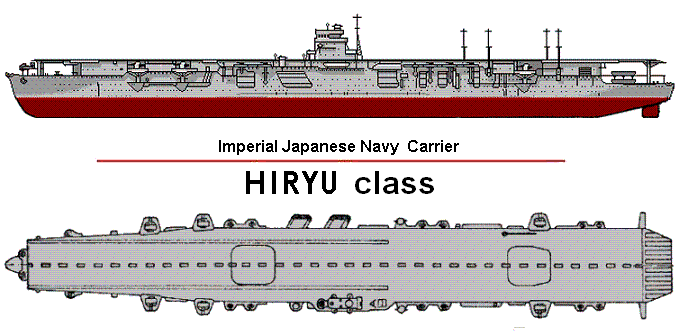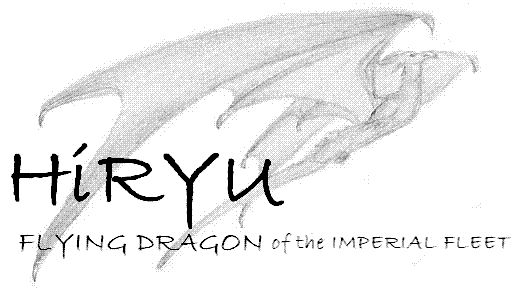
Imperial Japanese Navy - HIRYU Aircraft Carrier ==========================================================================

The Soryu (“Blue Dragon”) and Hiryu (“Flying Dragon”) represented the next generation of Japanese carriers and all future ships were based off their design that emphasized speed, a light build, and offensive power - but at a trade off in defensive power.
The Soryu class was built within the specifications of the Washington Naval Treaty that was in place at the time, which placed limits on its tonnage and armament. As a result, the Soryu and Hiryu were relatively small as fleet aircraft carriers compared to their later contemporaries during World War II, but were capable of carrying around 65 aircraft.
The Soryu displaced about 18,000 tons standard, had a speed of 34.5 knots, and handled 63 aircraft. The Hiryu was heavier, 18,500 tons standard, and had a speed of 34.3 knots. Officially, both ships were carried on the books as of 10,050 tons standard; the true tonnage was not revealed until after WW II. Both ships carried the same number of planes and had the same armament, 12 five-inch guns.
Soryu, built at Kure, Japan, was completed in December 1937. One of six carriers that delivered the Pearl Harbor attack on 7 December 1941, she also participated in other early Pacific War operations. Soryu was sunk on 4 June 1942, during the Battle of Midway, after SBD "Dauntless" aircraft from USS Yorktown (CV-5) hit her with several bombs which ingited fires that reached her fuel tanks with disastrous results.
A sister ship, Hiryu, built at Yokosuka, Japan, was completed in July 1939. Hiryu was a modified Soryu-class aircraft carrier, Compared to her near sister Soryu, Hiryu was almost four feet greater of beam, 2,000 tons heavier, and had her island superstructure placed on the port side and farther aft on her flight deck. She was also built with the deficiencies of the Ryujo in mind, which suffered from topweight problems as well as a small flight deck that delayed flight operations. Compared to the Ryujo, the Hiryu had a larger flight deck, more stable hull, and an endurance distance extended by nearly 3000 miles.
The port side island was an unusual arrangement; the only other carrier to share this feature was the Japanese aircraft carrier Akagi. The Akagi and the Hiryu were intended to work in a tandem tactical formation with normal starboard-sided carriers, in order to improve the flight pattern around the formation, but the experiment was not continued beyond those two carriers. The enlarged bridge design created turbulence, causing far greater deck accidents on the Hiryu than her sister carrier.
The Hiryu was one of the carriers that began the Pacific War with the attack on Pearl Harbor. Active throughout the first six months of the Pacific War, she took part in the December 1941 Pearl Harbor attack as well as operations in the East Indies and Indian Ocean area.
In April 1942 she took part in the Indian Ocean raid, striking Royal Navy bases at Colombo and Trincomalee Ceylon and helping to sink the cruisers Cornwall, Dorsetshire, the aircraft carrier Hermes, and her escort destroyer Vampire.
On 19 April 1942 she pursued the US carriers Hornet and Enterprise after they launched the Doolittle Raid, but failed to catch them.
On 4 June 1942 she took part in the battle of Midway. At 4:30 AM she launched a strike against Midway Island, destroying planes and damaging installations. After Kaga, Soryu and Akagi were disabled by air attack at about 10:25 AM, Hiryu was the only operational carrier left to the Japanese. She launched two waves of planes at 10:50 and 12:45 against Yorktown, heavily damaging the American carrier with bombs and torpedoes (she was sunk later by I-168).
Japanese search planes had located the remaining American aircraft carriers, and all surviving aircraft from the Carrier Striking Force had landed on Hiryu and were refueled and armed; but while preparing to launch a third strike against them, Hiryu was attacked at 5:03 PM by 13 SBD Dauntless dive bombers from Enterprise. She was hit by four 1000 lb (453.6 kg) bombs, three on the forward flight deck and one on or near the forward elevator. The explosions started fires among the aircraft on the hangar deck. The forward half of the flight deck collapsed into the hangar bay.
Although Hiryu's propulsion was not affected and she remained underway for a time, she had been fatally damaged and the fires could not be brought under control. At 9:23 PM her engines stopped, and at 1:58 AM a major explosion rocked the ship. The order to abandon ship was given shortly afterwards and the survivors were taken off by the destroyers Kazagumo and Makigumo. Rear Admiral Tamon Yamaguchi and Captain Kaku remained on board as Hiryu was scuttled at 5:10 AM by torpedoes from Makigumo. She sank at 9:12 AM, taking 350 or so men down with her who had been killed by the bombs, fires and explosions. Thirty-five were rescued by the US Navy and taken prisoner. Hiryu was the last of four Japanese aircraft carriers to be lost in the battle. Admiral Yamaguchi's insistence on going down with his carrier robbed the Japanese of one of their most experienced and brilliant carrier admirals.
=================================================================================
NB: The above text has been collected / excerpted / edited / mangled / tangled / re-compiled / etc ... from the following online sources :
Japanese aircraft carrier Hiryu - wikipedia article
Soryu Class Aircraft Carriers - www.globalsecurity.org




